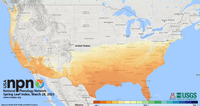Dakota Gardener: Gardeners await arrival of spring weather
(Click an image below to view a high-resolution image that can be downloaded)
By Esther E. McGinnis, Horticulturist
NDSU Extension
As a North Dakotan, I sometimes forget how early the spring growing season arrives for the rest of the country. During spring break, we traveled to the Washington, D.C., area. What a thrill to see our capital’s famous cherry blossoms in bloom!
Traveling to warmer climates in March and April is a double-edged sword for those living in the northern U.S. Sure, it is fun to experience short-sleeve weather when everyone is wearing their down parkas back home. However, the downside is experiencing profound depression upon returning to deep snowdrifts.
Today my hope is to help you keep the faith that the spring growing season will finally arrive. Here is a list of activities you can do while we wait.
One way of coping is to follow the USA National Phenology Network’s status of spring map. Sponsored by the U.S. Geological Survey and the University of Arizona, this map uses models to predict spring’s arrival based on the effect of temperature and precipitation on leaf out and bloom of selected early-flowering shrubs. The first leaf index is finally approaching southern Nebraska and Iowa.
Interestingly, the first leaf and bloom indices show that spring was very early in the southeastern U.S. In contrast, spring is late in southwestern states like California and Arizona likely due to frequent rain storms.
If you are looking for something active to do, consider giving your houseplants a little TLC. During winter, we decrease watering and stop fertilizing because growth slows and some plants may go dormant. As daylength increases, houseplants resume growth. Regular watering and fertilizer applications are encouraged at this time.
Don’t forget to include your houseplants when you spring clean. Wipe the dust from leaves with a moist towel. Dust impairs the plant’s ability to receive sunlight.
If you can fight your way through the snowbanks, now is the perfect time to prune your trees and shrubs. Pruning in early April is encouraged for a number of reasons. In the absence of leaves, tree and shrub infrastructure is visible. Disease organisms such as fireblight are not active. Furthermore, pruning wounds will heal rapidly once growth resumes.
One caveat—don’t prune your spring flowering shrubs like lilac and forsythia. Pruning at this time of year will cut off the flower buds.
For those of you that love to grow a beautiful lawn, be on the lookout for snow mold. The risk of snow mold increases as the length of snow cover exceeds 90 days. As the snow melts, you may see the cottony growth of snow mold. Once the area is no longer muddy, rake out the matted grass and overseed in areas that are severely impacted.
A wonderful way to prepare for the spring growing season is to attend NDSU Extension’s spring gardening workshops. Dakota Garden Expo in Bismarck, Gardening Saturday in Grand Forks, Garden Palooza in Fargo and the Mountrail County Home & Garden Show are great educational opportunities.
NDSU Agriculture Communication – March 28, 2023
Source: Esther McGinnis, 701-231-7406, esther.mcginnis@ndsu.edu
Editor: Kelli Anderson, 701-231-6136, kelli.c.anderson@ndsu.edu




